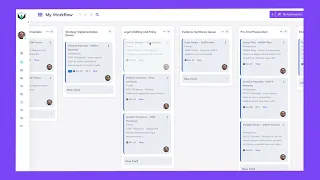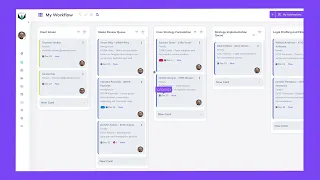Automation is the unsung hero behind modern legal operations. In 2025, mid-size law firms are aggressively automating repetitive, time-consuming tasks, from document generation to task management, to do more with less. The American Bar Association’s tech survey reveals that 73% of firms now utilise cloud-based legal tools, with practice management and document automation software leading the way.
This trend is significant because a substantial portion of legal work is ripe for automation. Clio’s research found that 74% of billable work handled hourly could potentially be automated by generative AI and technology.
By automating such routine work, firms can boost productivity, reduce errors, and control costs, all while freeing up attorneys for complex, billable tasks that truly require legal expertise.
In an environment of intense competition and client demand for value, automation is becoming essential for sustainable growth.
Why Automation Matters for Mid-Size Law Firms
Law firms are prioritizing tech that drives efficiency. For example, according to Smokeball’s Annual State of Law Firm Productivity, in choosing software, firms now emphasize ease of use, automation, and workflow integration over cost, a shift that acknowledges that better workflows translate to better profitability.
It’s paying off: 62% of firms that adopted case management systems reported a marked increase in client satisfaction, thanks to smoother processes (fewer missed deadlines, faster updates) and more transparent workflows.
Mid-size law firms often juggle multiple cases and clients simultaneously. Efficiency is paramount, yet many attorneys still shoulder heavy administrative loads. The convergence of recent data underscores a fundamental truth: a substantial portion of legal work is ripe for automation.
For these mid-sized law firms, automation has quickly emerged as the unsung hero driving efficiency, profitability, and client satisfaction. By offloading repetitive tasks from document generation to task management, firms are now freeing their attorneys to focus on work that demands skill and experience.
Key Benefits of Automation
Automation delivers transformative benefits for mid-sized law firms looking to scale efficiently. One of the most immediate advantages is boosted productivity.
By relieving teams of repetitive and time-consuming tasks, attorneys are empowered to focus on higher-value work that directly contributes to business growth, such as strategy development, client engagement, and revenue-generating activities.
Cost control is another major advantage. Automating standard workflows helps minimise errors and rework, which can otherwise lead to increased operational costs and delays.
When processes run smoothly and accurately the first time, the overall financial health of the organisation improves.
Ultimately, automation offers a significant competitive advantage. As more clients expect faster service and digital transparency, law firms that embrace smart automation tools position themselves as forward-thinking, responsive, and capable of delivering modern customer experiences.
In this way, automation is not just about cutting costs; it’s a catalyst for long-term, scalable success.
These findings reinforce a seismic shift: if software isn’t making everyday tasks faster and easier, it doesn’t stand a chance in modern legal operations.
Practical Outcomes: Doing More With Less
When automation works behind the scenes, the entire operation flows more smoothly. Attorneys and paralegals can focus on tasks that require critical thinking, face-to-face interaction, and strategic planning, such as meeting clients, crafting legal strategies, and handling complex negotiations.
- Reduced Errors: By automating routine and repetitive steps, businesses significantly reduce the risk of mistakes that come from manual data entry or inconsistent processes.
- Higher Billable Hours: With less time spent on administrative tasks, legal professionals can devote more hours to client-focused, revenue-generating work.
- Happier Clients: Automation leads to quicker turnaround times, clearer communication, and fewer obstacles, all of which improve the overall client experience and strengthen long-term relationships.
Final Thoughts
Legal automation is no longer an option; it’s an essential pillar for success in 2025 and beyond. As the legal industry becomes increasingly complex and client expectations rise, firms that embrace automation will gain a significant competitive edge.
Automating administrative and procedural workflows allows legal professionals to reduce overhead, minimise human error, and maintain compliance with evolving regulations.
More importantly, it frees up time for lawyers to focus on client strategy, case development, and other high-value activities that require human judgment and creativity.
Firms that seize the opportunities of automation will find themselves better positioned to deliver consistent value, scale sustainably, and attract and retain top talent in a demanding and fast-changing legal landscape.
Making the Move to Automation: A Simple Next Step
If your firm is feeling the strain of administrative backlogs or struggling to keep up with client demands, automation could be the key to unlocking untapped growth.
When you’re prepared to streamline daily operations and position your firm for the future, Legalboards stands ready to help. Explore how we can transform your practice by automating the routine, so you can excel where it truly counts.
Schedule a free demo of Legalboards or visit our blog for more insights.
Revolutionize your practice- one automated task at a time!
Frequently Asked Questions
What tasks in legal operations are best suited for automation?
Routine and repetitive tasks such as client intake, case updates, document generation, and deadline tracking are ideal for automation. These tasks consume valuable time and are prone to human error.
Legalboards simplifies these processes by offering visual workflow boards that automate case progression, ensuring that important steps aren’t missed and staff stay focused on high-value legal work.
How can automation help improve compliance and reduce risk?
Automation reduces the chances of missed deadlines, incorrect filings, and data inconsistencies by creating standardised, rule-based processes. It also ensures key compliance steps are never skipped.
Legalboards enhances this by allowing firms to embed compliance checkpoints directly into their workflow boards, giving teams visual and automated cues to stay on track and avoid costly mistakes.
Will legal automation reduce the need for legal staff?
No. Automation is designed to support legal teams, not replace them, by handling time-consuming administrative work. This allows lawyers, paralegals, and support staff to focus on strategic and billable tasks.
Legalboards augments human effort by providing automated task assignments, calendar syncing, and status updates, keeping the team informed without unnecessary manual input.
How do law firms measure the return on investment (ROI) of automation?
ROI is typically measured by the time saved, increased billable hours, reduced errors, and improved client satisfaction. Firms often see faster case resolutions and smoother operations after implementing automation.
With Legalboards, firms can track progress across cases, monitor task completion rates, and evaluate how automation is accelerating workflows and reducing bottlenecks, all within a single platform.
Is it difficult to implement automation in an existing legal tech stack?
Not necessarily. Many modern automation tools are designed to integrate with common legal practice management systems, requiring minimal disruption. The key is choosing flexible, user-friendly solutions.
Legalboards integrates seamlessly with popular platforms like Clio and Microsoft 365, allowing firms to enhance their existing workflows without having to overhaul their entire tech stack.








